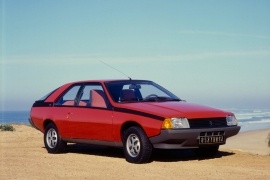RENAULT Fuego Models/Series Timeline, Specifications & Photos
First production year: 1980
Engines: Gasoline
Body style: Coupé (two-door)
Renault was keen on keeping a sporty product on the European market and, in 1980, it launched the Fuego (Fire), aiming at the Ford Capri and Volkswagen Scirocco.
Like its predecessors, the models 15 and 17, the Fuego shared its platform with another big-selling vehicle from Renault's lineup, the 18. Unfortunately, that platform was already old since it was based on the Renault 12 from the mid-'60s. But still, the vehicle's shape was sporty and helped the carmaker sell more than 260,000 units.
The styling was appealing, with a fastback appearance and two doors. It offered a sporty look. Its door handles were hidden behind the vertical cut of the doors, leaving only the keyhole visible. At the front, the rectangular headlights and the tilted grille also increased the sporty look of the car. Its raked windshield and low roof led to a smaller cabin and narrow windows. As an option for several markets, the carmaker offered a canvas top that opened the car's roof.
Inside, the carmaker installed sport seats with high bolstering for the front passengers and a tiny bench in the rear fit mostly for purses and bags than for adults. The driver benefited from an adjustable steering column and a neat instrument panel with the fuel and temperature gauges in the middle, flanked by the speedometer on the left and the tachometer on the right. On the center stack, Renault installed the AC controls and a stereo.
Even though it shared its underpinning with the Renault 18, the Fuego benefited from a few parts carried over from the larger Renault 20. Thus, the carmaker managed to avoid further development costs by using what it had in stocks. Under the hood, depending on the market, the Fuego featured a wide engine range between 1.4- and 2.2-liter.
